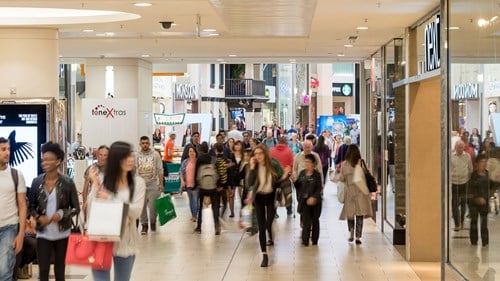A new report that surveyed consumers in several European countries suggests some key areas in which physical retailers are failing to meet the in-store expectations of shoppers.
A major challenge facing physical retailers is how to satisfy “connected consumers” whose expectations are shaped by their ability to flex easily between physical and online stores.
 Consumers’ in-store expectations are increasingly being shaped by their ability to flex easily between online and physical retail. Image: intu group
Consumers’ in-store expectations are increasingly being shaped by their ability to flex easily between online and physical retail. Image: intu group
With this in mind, retail analytics firm ShopperTrak surveyed consumers in five European countries: France, Germany, Italy, Spain, and the United Kingdom and asked them about their greatest frustrations with in-store shopping. This article describes two of them: checkouts and quality of staff.
Shorter queues and easier checkouts
Queuing to pay frustrates many consumers – perhaps the fact that they don’t have to queue when online shopping sharpens their in-store expectations.
The survey found that nearly half (44 percent) of those surveyed said that they wanted shorter queues in stores, with consumers in France topping the list (47 percent).
Nearly a third of consumers (31 percent) said that they would abandon their in-store purchase if they thought the queue was too long.
Even if queues are short, there can be frustration if the checkout is slow. Nearly a third of those surveyed said that they want faster and easier checkout options, such as contactless card and mobile payments.
A personal experience as a connected consumer
Three years ago, I went into a well-known department store and asked them which of two computers on display they would recommend. The in-store assistant pulled out a tablet (that was a nice touch – I became hopeful), located the product details in their online store, and invited me to read them.
I politely informed them that I had already done that, and what I wanted was a more in-depth discussion of the pros and cons with an expert. They couldn’t help me. Their knowledge was limited to what was written in the product details section of their online store.
Last month I went into the same store with nearly the same question. Again, I had whittled down my choice to two laptops and my decision was getting stuck on the trade-off between physical weight and processing power. They were about the same price, but one was powerful and a bit heavy, while the other was lighter, but less powerful.
This time I was served by a keen – but not pushy – in-store assistant who quickly established my level of knowledge, where I had already looked online and in other stores, and asked me some insightful questions about my job and how I intended to use the computer. He recommended that I buy the apparently less powerful, but lighter, machine.
He used the proposed laptop (nice touch) to show me that although it had a less powerful chip, for the usage I intended, it was more than adequate and with my needs I would probably value the lighter weight more.
In-store staff must be knowledgeable and not pushy
While my example is a single and statistically meaningless event, it probably sums up the in-store expectations of connected consumers who increasingly regard the physical store as the place where they can get more information and advice from a human expert than they can from the online store.
ShopperTrak say that this is one reason that online retailers like Amazon are beginning to explore bricks and mortar retail. They also cite another report that suggests “pure play” online retail is dying.
Their survey found that a quarter (25 percent) of European shoppers want physical retail staff to be better skilled and informed. They also want them to be able to direct them to product information and reviews online and to quickly check stock availability.
It also found that 15 percent of shoppers are actually put off purchasing in shops where the staff have poor product knowledge.
ShopperTrak say that the survey shows that there is work to be done in this “make or break” area of customer service if retailers are to meet in-store expectations.
While many retailers are already providing tablets and other ways shoppers can quickly access product information in-store, they are not matching this with knowledgeable, trained staff.
The survey also found that consumers do not want pushy staff. Sometimes over-eagerness can put them off.
More than a quarter (27 percent) of survey respondents said that they would leave the store if the assistants were too pushy. The exception was Germany, where there appears to be a higher level of tolerance to eager sales staff.
The report quotes James Daunt, managing director of the book retailer Waterstones, summing up the challenge of satisfying the in-store expectations of today’s shoppers:
“High street retailing is a recreational rather than a practical exercise now to a significant degree. The days of an absolutely practical stand-and deliver shop are limited.”

